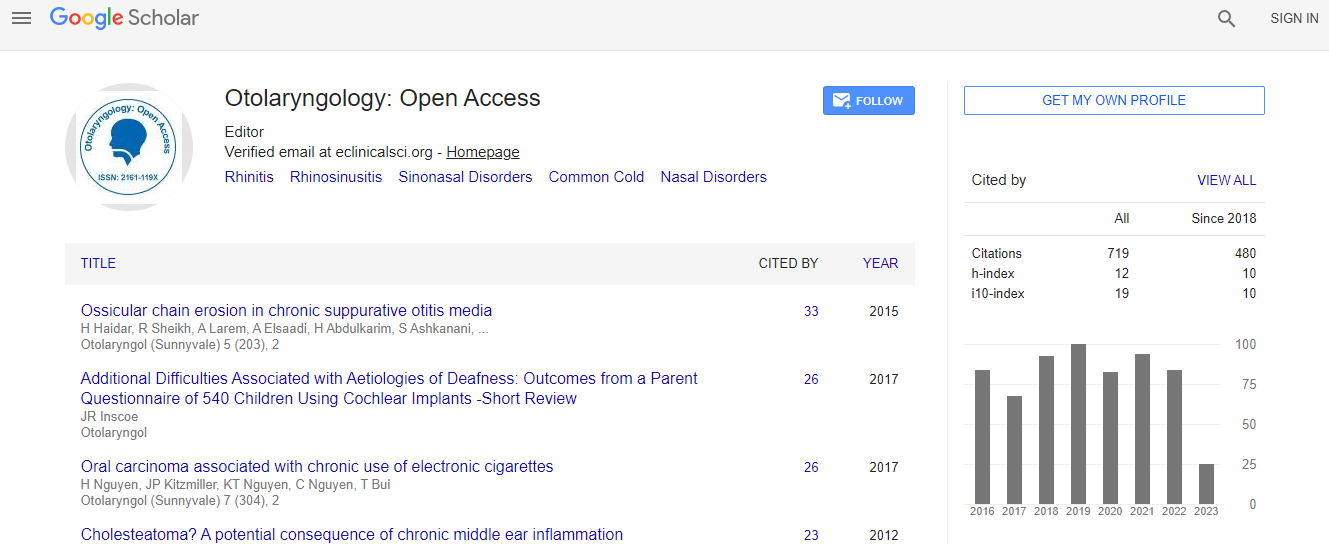Our Group organises 3000+ Global Events every year across USA, Europe & Asia with support from 1000 more scientific Societies and Publishes 700+ ������ Journals which contains over 50000 eminent personalities, reputed scientists as editorial board members.
������ Journals gaining more Readers and Citations
700 Journals and 15,000,000 Readers Each Journal is getting 25,000+ Readers
Citations : 925
Indexed In
- Index Copernicus
- Google Scholar
- Sherpa Romeo
- Open J Gate
- Genamics JournalSeek
- RefSeek
- Hamdard University
- EBSCO A-Z
- OCLC- WorldCat
- Publons
- Geneva Foundation for Medical Education and Research
- ICMJE
Useful Links
Recommended Journals
Related Subjects
Share This Page
Eagle syndrome: A case presentation
International Conference on Aesthetic Medicine and ENT
Fazel Khaliq Omari
National Military Hospital, Afghanistan
Posters & Accepted Abstracts: Otolaryngology
DOI:
Abstract
Introduction: Eagle syndrome characteristic is constant pain in the oropharynx and face, the cause is elongated styloid process or calcified stylohyoid ligament. Eagle syndrome (ES) is first time described, by an otolaryngologist, Watt W. Eagle, in1937. The stylohyoid complex is made of styloid process, stylohyoid ligament, and the small cornus of the hyoid bone. The normal length of the styloid process is individually variable, but in the majority of patients it is about 20 mm. Eagle��?s syndrome is treated surgically and nonsurgically. A pharmacological approach by transpharyngeal infiltration of steroids or anesthetics in the tonsillar fossa has been used, but styloidectomy is the treatment of choice. Styloidectomy can be performed by an intra- or an extraoral approach. Case Presentation: A 22 years old male, presented with complain of recurrent sore throat with frequently odynophagia and sometime ear ache on both side (predominantly on left side) since one year. By taking the history, pharyngoscopy and evaluating the radiography, the diagnosis of elongated processus styloideus and recurrent acute tonsillitis was made. After completing the blood examination and anesthesia consultation, patient selected for tonsillectomy and bilateral styloidectomy under local anesthesia. At first tonsillectomy was done, then processus styloideus identified intraorally and dissected from periost, and 1cm from the middle end catted. The pharyngeal wall was repaired no serious bleeding, Augmentin injection advised preoperatively and postoperatively, patient discharged from hospital after 48hr. Three months after procedure patient checked again with no complain. Conclusion: Already eagle syndrome is a rare case, sometime the coexistence of recurrent acute tonsillitis (RAT) and chronic tonsillitis(CT) at the same patient may mask the diagnosis of elongated process styloideus and for that reason if the odynophagia is persistent in a patient with RAT and CT, for evaluation of processus styloidus it is better to do at least the plain neck lateral radiography.Biography
Fazel Khaliq Omari was born in 1972 in Kabul Afghanistan. He was graduated from Kabul Medical University in 1997. He has been working in the field of otolaryngology since1997.He was graduated from ENT residency program in National Military Hospital as an ENT Specialist in 2005.
Email: ofazelkhaliq@gmail.com

